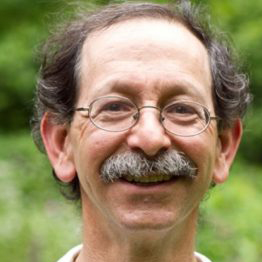
By Arnie Alpert, Active with the Activists
Arnie Alpert spent decades as a community organizer/educator in NH movements for social justice and peace. Officially retired since 2020, he keeps his hands (and feet) in the activist world while writing about past and present social movements.

CONCORD—Travelers headed to New Hampshire’s lakes and mountains Friday afternoon were treated to a series of banners expressing messages like “Resist,” “No Kings,” “Fight Fascism,” and “No Troops in US Streets,” accompanied by American flags. It was the latest outing for the NH Bridge Brigade for Democracy, which said it had teams on 25 overpasses.
A national group of bridge protesters called it “Be Brave Day.”
In Concord, on the overpass connecting the NH Technical Institute campus with Horseshoe Drive by the Delta Dental office, a small group unfurled their banners at about 4 p.m. and fixed them to the chain-link fences with clips and bungee cords. “Help Save Our Country,” read the biggest one. Another said, “We Are Not OK.” Erin Reed, of Bow, held one that said, “Time to Speak Up.” Deb Gaudette had one that said, “ICE = Gestapo.”
“Democracy is the overall umbrella,” said Deb Jadczak, a Concord resident who coordinates the group that gathers on what they call the “Delta Dental Overpass.”
The overpass protests started a few months ago. “From that, a couple of people, Jamie Cunningham and Greta Roberts, sort of took over and created this visibility brigade for New Hampshire to reflect what was going on nationally,“ Jadczak said. From just a few bridges at the outset, the project now includes overpasses from the Massachusetts border to Franconia Notch on I-93, with others on I-89, I-95, Route 101, and the Everett Turnpike.
Jadczak’s group started in April, she said, “and we’ve been out here every couple of weeks since, depending on the day, to catch the right traffic. Today, being Friday, everybody’s going north.”
Response from motorists creeping along the busy highway has been mostly positive she said, judging by friendly waves, honks, and the thumbs-up to middle-finger ratio.
Under the democracy “umbrella,” she said, “is everything from ICE, the way we’re treating the homeless, the way we’re treating our immigrants, the cuts to the budget in favor of the rich.”
Boscawen resident Deb Gaudette said that standing with others on the bridge waving to motorists is good for her mental health. She remembers going to Seabrook protests decades ago when she was in high school, but said she has not been a frequent protester in the intervening years. Nowadays, she gets out in public about once a week.
Gaudette is part of a movement that appears to be growing. According to the Crowd Counting Consortium, the June 14 “No Kings” protests involved somewhere between 2 and 4.8 million people, a turnout two to three times larger than the “Hands Off” protests in April.
Greta Robers, a Wilmot resident who serves as one of three statewide coordinators, said the New Hampshire teams are part of a decentralized national movement of bridge protesters. Across state lines, they trade tips on sign-making technology, safety, maintaining nonviolent discipline, and political messaging.
Painting letters on pieces of foam board is a good technique, Roberts said, because groups are able to change their messages from week to week. Sheets are really good, too, she said, as are shower curtains. The key is to make the letters big enough, 12 to 18 inches high, to be seen from a distance.
Visibility Brigade, a New Jersey-based group that provides resources and coordination to groups like the New Hampshire one, lists contacts in 41 states and DC on its website. They also offer a 55-page “toolkit” loaded with tips.
“Popular mobilization through protest is neither the entirety of the opposition to the Trump administration nor sufficient in and of itself to compel change. But historically, the mass public — in tandem with other societal actors like opposition politicians, lawyers, labor unions and courts — is likely to continue to play a crucial role in the U.S. and elsewhere in standing for the rule of law and democratic norms,” according to a recent article by political scientist Erica Chenoweth and others from the Crowd Counting Consortium.
Bill Carr, a retired teacher living in Concord, said he started attending local protests earlier in the year but this was his first time on the bridge. He said he finds it encouraging that so many people share concerns about the assault on liberal democracy.
“Today, you gave hope—to me, to New Hampshire, to each other, to everyone who believes democracy is worth fighting for,” Greta Robers wrote on the group’s Facebook page. “In fact, more of us showed up than ever before, and we showed this state (and those who would take our rights from us) what it looks like when ordinary people refuse to back down.”
The next big day for the Bridge Brigades will probably be Labor Day. The banners will be facing into southbound traffic.





